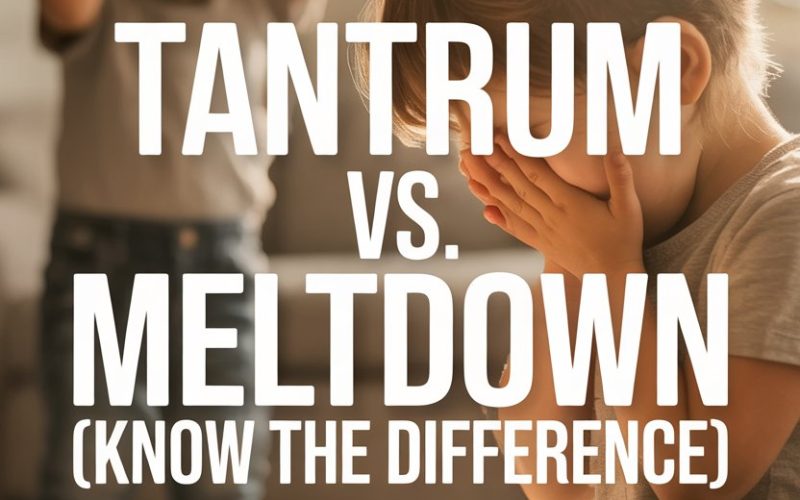If you’ve ever found yourself clutching a coffee in one hand and a wailing toddler in the other, you’ve probably wondered—sometimes with a hint of desperation—“Is this a tantrum, or is my child actually having a meltdown?”
There’s a difference, and knowing which one you’re dealing with can make all the difference between managing with grace and, well, hiding in the pantry with the biscuits.
Let’s sort the chaos.
Why Knowing the Difference Matters
Both tantrums and meltdowns are loud, messy, and public enough to make you question your life choices. But here’s the rub: they come from very different places in a child’s brain.
Understanding what’s happening under the surface can change everything from how you respond to how you recover. Parents often beat themselves up over public outbursts, but knowing the cause puts you back in the driver’s seat.
What Exactly Is a Tantrum?
Tantrums are those spectacular performances—often starring your child as the dramatic lead—that usually pop up when a want is thwarted.
Imagine this: your three-year-old spots a shiny chocolate bar at the checkout. You say, “Not today.”
Suddenly, there are tears, stamping feet, wails that could summon the neighbours. That’s a classic tantrum.
Tantrums tend to be:
- Purposeful (yes, really)
- Aimed at getting something
- Usually stop if the child gets what they want—or if the audience disappears
These emotional eruptions come from frustration or a desire for control. Kids have big feelings, tiny vocabularies, and an overwhelming need for autonomy. When that combo hits a wall, welcome to Tantrum Town.
What About a Meltdown?
A meltdown, on the other hand, isn’t a finely tuned act. It’s more like a system overload.
Picture your child as a phone with too many apps open—eventually, it freezes. Meltdowns happen when kids are overwhelmed, out of resources, and can’t regulate any longer.
Meltdowns are:
- Not about getting something
- Often triggered by sensory overload, exhaustion, hunger, or unexpected changes
- Harder to “turn off” with bribes, distractions, or reasoning
For kids (especially those with autism, sensory processing challenges, or ADHD), meltdowns are involuntary. Their brains are simply flooded. They aren’t manipulating or misbehaving—they’re in distress.
Clues You’re Dealing With a Tantrum
Not every shouting match in the supermarket is a clear-cut case. Here’s what to watch for if you think a tantrum’s afoot:
- They’re checking if you’re watching. (Peekaboo, but with more volume.)
- The crying pauses if they get what they want—or if nobody’s paying attention.
- There’s a clear “goal,” like sweets, a toy, or staying up late.
- They might escalate, then suddenly snap out of it if they sense a lost cause.
Tantrums are part of development, and nearly every toddler will star in their own version at some point. Even the ones whose parents seem suspiciously serene at playgroup.
Clues You’re Witnessing a Meltdown
Meltdowns look different. Sometimes they’re mistaken for “bad behaviour,” but the reality is far more complicated.
- The child seems lost to the world—no longer aware of your reaction.
- No obvious goal. They’re not after anything except relief from distress.
- Intense physical responses: shaking, screaming, hitting, or shutting down completely.
- Even after the trigger is removed, the meltdown doesn’t immediately stop.
Children having meltdowns need support, not discipline. Their nervous systems are on fire, and reasoning won’t land until things cool down.
What Sets Them Apart? Emotions, Not Intentions
If tantrums are about “I want,” meltdowns are about “I can’t cope.”
Tantrums have a whiff of performance. Meltdowns are as involuntary as hiccups.
The line can blur—tantrums can spiral into meltdowns if a child becomes overwhelmed. It’s not a science experiment. Some days, it’s more like alchemy.
Neuroscience agrees with tired parents everywhere: self-regulation is hard work for little people.
According to Dr. Mona Delahooke, a clinical psychologist and author of Beyond Behaviors, the key is recognising when your child has lost control versus when they’re still negotiating.
Handling Tantrums Without Losing Your Mind
Dealing with a tantrum? Here’s your game plan, straight from the trenches.
Stay calm(ish). Channel your inner duck—serene on top, paddling like mad underneath.
Acknowledge their feelings. “You’re upset because you can’t have that biscuit. It’s tough to wait.”
Set clear, loving boundaries. If the answer’s no, it stays no.
Ignore the performance aspect. If it’s safe, don’t provide an audience.
Praise recovery. Celebrate when your child regains composure.
Research suggests that consistent, calm responses help tantrums become less intense over time.
Harvard University’s Center on the Developing Child backs this up: warm, predictable environments foster resilience—even in the midst of supermarket squalls.
Supporting Your Child Through a Meltdown
Meltdowns require a different toolkit. Here’s a cheat sheet:
Create safety. Move your child somewhere quiet if possible.
Reduce stimulation. Dim lights, lower voices, remove extra noise or crowds.
Stay close. Sometimes kids want a cuddle; sometimes they need space. Follow their lead.
Limit language. Talking too much can add fuel to the fire.
Wait it out. After the storm, offer comfort and a drink or snack.
Dr. Temple Grandin, an expert on autism, emphasises that meltdowns are physical, not emotional. Her own experiences and research suggest that pressure vests, weighted blankets, or fidget toys can help some children to self-soothe.
When Tantrums and Meltdowns Collide
Life rarely fits neatly into boxes. Sometimes, tantrums escalate into meltdowns. A child upset about a denied treat might push their system into overload if they’re already tired, hungry, or overwhelmed by noise.
In these moments, your best bet is to shift strategies—to handle both the emotion and the sensory overload.
Try this: Begin with clear, calm boundaries, then pivot to meltdown support if you see your child losing the ability to reason or respond.
What Triggers Each?
Tantrums usually spring from:
- Frustration (toys that won’t cooperate, rules that seem unfair)
- Limits on independence (“No, you can’t eat crayons for breakfast”)
- Delayed gratification
Meltdowns are more likely to erupt from:
- Sensory overload (bright lights, loud sounds, itchy labels in jumpers)
- Sudden changes or disruptions in routine
- Fatigue, hunger, or illness
- Emotional overload—too many feelings, too few words
Parents of children with autism or sensory processing differences may spot meltdowns more frequently, though every child has their limit.
How to Prevent Tantrums and Meltdowns
No one can avoid every sticky situation, but a few tweaks can reduce the frequency and intensity:
- Keep routines predictable. Children thrive on knowing what’s next.
- Offer choices. “Do you want the blue cup or the red one?”
- Use visual schedules or timers for transitions.
- Name emotions for your child. “You’re feeling cross because it’s time to leave the park.”
- Watch out for triggers—hunger, tiredness, overstimulation—and plan accordingly.
The Zero to Three parenting resource hub offers tips for building emotional literacy, which can help children communicate needs before things boil over.
When to Seek Extra Support
If both tantrums and meltdowns are constant, extreme, or violent, it might be a sign of something more than typical development. Trust your instincts.
Support from a pediatrician, psychologist, or occupational therapist can shed light on underlying issues like sensory processing disorder or anxiety.
Plenty of families find relief through early intervention, and there’s no downside to getting a little help. No gold medals for suffering in silence.
What About Siblings and Public Meltdowns?
Ah, the sibling effect. Tantrums and meltdowns have a fascinating way of multiplying when siblings are around—sometimes out of solidarity, sometimes out of competition.
Try not to compare children, and avoid fuelling rivalry by giving in to one but not the other.
In public? Breathe. Most onlookers are silently cheering you on.
For those who aren’t—well, let’s hope their day brings them more empathy soon. A calm, firm response sends the message that you’re handling it, even if your heart’s racing like you’ve just run a 5k.
Self-Care for Grown-Ups
Don’t forget yourself in all of this. Responding to big emotions requires you to have at least a thimbleful of patience left (no easy feat on three hours’ sleep).
Call a friend, take five minutes to stare at your own ceiling, eat something that isn’t a half-chewed rice cake. Parenting is a marathon, not a sprint, and nobody finishes with clean hair or unscathed nerves.
Tantrums and Meltdowns: You’ve Got This
The next time your child is mid-howling in the supermarket, take a breath. Is this a power play, or a system overload? Your response matters more than perfection.
All those gentle boundaries and soothing words will pay off, even if it doesn’t feel like it in aisle five.
You’re the expert on your child. You know the difference between crocodile tears and real distress better than anyone else.
With a little practice, a lot of patience, and permission to laugh at the absurdity of it all, you’ll handle whatever your little one throws at you (metaphorically… and occasionally, literally).
Keep calm, carry snacks, and know that you’re not alone in this wild ride.





